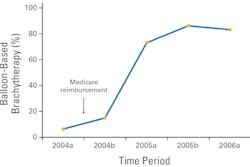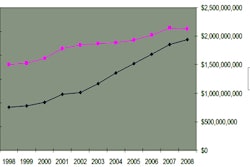Women who have recurring breast cancer after breast conservation surgery and radiation therapy seldom have the option to save their breast -- a mastectomy is the recommended treatment. However, there may be another option, according to an article published in the April issue of Brachytherapy.
Patients treated at the Antoine Lacassagne Cancer Center in Nice, France, were offered the option of having a second lumpectomy followed by high-dose-rate interstitial brachytherapy between June 2005 and July 2009. Forty-two women selected this treatment for their second cancer in lieu of a mastectomy.
After almost two years of follow-up, clinical outcomes with respect to both local control and cosmesis are promising, according to lead author Dr. Jean-Michel Hannoun-Levi of the department of radiation therapy.
The women were all diagnosed with a breast carcinoma measuring less than 30 mm in diameter. The cancer recurred a median of 11 years following diagnosis and treatment of the primary breast tumor, although it occurred within a year for some and as long as 35 years later for others. Patients were a median of 65 years old at the time of the second diagnosis, although the age range was 30 to 85 years.
For the majority of patients (29, or 69%), the primary tumor was located in the left breast. Breast cancer recurred in the tumor bed for 22 patients and in the same quadrant for 14 patients. An invasive ductal carcinoma was the predominant histology, at 78.6%, and the median size of the tumor was 12 mm, with a range of 2 to 30 mm.
Each patient had a lumpectomy with a gland dissection up to the pectoralis muscle, with intraoperative implantation of plastic tubes in the tumor bed. All patients received a total radiation dose of 34 Gy in 10 fractions over five consecutive days. Patients began to be monitored 25 days after treatment completion, and were then evaluated every six months thereafter.
Twenty-two patients developed complications, which were primarily cutaneous and subcutaneous fibrosis (72%), followed by pain (28%) and telangiectasia (21%). One patient fractured a rib. The majority of toxicities were grades 1 and 2, with only one patient experiencing a grade 3 toxicity.
Both patients and clinicians were pleased with the cosmetic outcomes, rating visual assessment as 10 on a scale of 10. Only one patient had local failure, with her cancer metastasizing.
While the authors emphasized that at a median 21-month follow-up, it's too early to evaluate overall survival for this small patient cohort, they questioned the feasibility of implementing a phase III randomized trial comparing survival outcomes of patients who undergo a mastectomy with those who have a second conservative radiosurgical treatment.
The researchers intend to continue following and reporting on the outcomes of these patients.



















